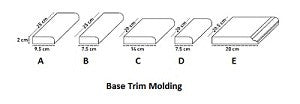Cement Tile FAQ's
Answers to frequent questions about cement tile and encaustic cement tile.
Are any of your cement tiles rated for freeze thaw cycles?
Yes, these cement tile lines are rated for frosty environments:
Can I cut the moldings if I want a narrower width than 3-inches?
Yes. You can cut the moldings down to 1" width and still preserve the rounding of the bullnose. Remember to cut cement tiles with a wet saw and diamond blade.
Can I get a double bullnose or corner bullnose piece?
Yes. You can get a solid color cement tile in a double bullnose molding or base trim (3" x 10" Heritage Base Trim). You need to specify which ends or corner needs the bullnose, though. This is available in most of our cement tile lines.
No. Only plain or solid color cement tile base trim is available with a bull nose in most lines.
Can I transition to a double bullnose from a single bullnose edge?
Yes. You can use single bullnose molding (5.5" x 8") and transition to double bullnose 3" x 10" to make a smooth transition on a wall application. There is about a 1 mm to 0.5 mm difference in the radius.
Can I install cement tiles in my home if I have a wooden sub-floor?
Yes. For residential flooring applications, we recommend you make sure to install cement tiles on a backer board with a 1/2" plywood sub-floor above the floor boards. However, if the house is on a hill or an older home and subject to settling, the floor may suffer some damage due to movement over time. This slow movement or settling may cause some tiles to break over time; but, it is very rare. Most importantly, an extremely level surface is critical for any cement tile floor installation. For commercial applications, we only recommend that you install over a flat, level and stable cured concrete surface.
Can I miter the bullnose trim to create a picture frame for a wall application?
Yes. The bullnose moldings can be mitered to create a picture frame effect just as you would standard molding.
Can I miter cement tile so that it wraps around a wall creating a seamless effect with the pattern?
It is not recommended to miter the cement tiles. While this can be done the waste factor is extremely high. Usually two tiles are needed to create a one good mitered tile.
Can I use cement tiles for my pool?
Yes. But you need to seal the tiles with a sealer that is appropriate to withstand pool chemicals. Avente Tile offers NO guarantee in resistance to chemicals.
Cement tiles can and have worked in pool applications; but we have not controlled the sealing process.
Cement tiles can and have worked in pool applications; but we have not controlled the sealing process.
Can I use stone as a border outside .the 'rug' or patterned cement tile area?
Yes. Stone, travertine or marble can be used instead of a solid color cement tile. In fact, cement tile floors are very frequently installed this way.
Can you use radiant heat sources in the floor with cement tile?
We haven't had any specific experience with using radiant heat in cement tile floors, but it should not be a problem. Follow the manufacturer's recommendation as you would for ceramic tile floors and make sure to evenly distribute the heat source over the flooring area.
Do I need to seal my cement tile before grouting?
You may seal your tile prior to grouting, to act as a grout release. Some of our cement tile comes pre-sealed (Mission Cement Tiles). This is not as important for polished tile as it is for raw or unpolished cement tile. Polished tile have a smoother surface and grout does not stick to them as much as unpolished or raw concrete. The tile must be sealed again after installation and grouting.
How do I install and maintain cement tile?
Installing cement tiles is a fairly simple process. Cement tiles are installed similar to stone. Make sure to apply a penetrating sealer after installation is complete because cement is a porous material, like natural stone. Follow the specific installation guide for the tile you purchased and make sure to review our How to Install Cement Tiles - An Illustrated Guide.
How do I install cement tiles when used with other floor coverings that have a different thickness?
To account for the difference in thickness of the cement tiles (about 5/8") and other flooring (typically around 3/8"), you can raise the height of the thinner area with a thicker underlayment (backerboard) attached to the subfloor or you will need to put in a transition threshold or molding that allows for the slight step up. The transition is most commonly used when different covering materials are used in different rooms and occurs at each entry. The underlayment option is easily used for new construction, remodels, or where different coverings are used in the same room and a transition would be awkward.
I like cement tiles, but how much do they cost per square foot?
The cost for most cement tiles ranges from about $10 - $12 per sq. ft. for plain tiles and $15 to $25 per square foot. Colors, patterns, size, and finish all impact the final price.
I want to install a bar foot rail or bar shelf support, how do I drill a hole through the tile?
A diamond head drill should work fine. We recommend that the installer complete a test run first with the desired bit size and the edge of the cut should be at least 1" from the edge of the tile.
What color grout can I use with my cement tile?
You may use colored or white grout. If you decide to use colored grout we recommend that it be a color that is the same, or lighter than the lightest color used in the pattern.
What do I need to know about cement tile before I buy?
Cement tile is different in many respects than its more ubiquitous cousin, ceramic tile. It's these differences that often surprise folks and let's face it, nobody needs a surprise like that. To prevent that kind of a surprise, we thought we'd detail what you need to know before buying cement tile. This handy guide should help you understand Cement Tile: 7 Things You Need to Know Before You Buy.
What sizes of cement tile base trim or molding are available?
- 3.75" x 10" (A)
- 3" x 10" (B)
- 5.5" x 8" (C)
- 3" x 8" (D)
- 8" x 8" Skirting with a Decorative Edge (E)

